Abstract
This study demonstrates an essential role for interleukin-4 (IL-4) in the delayed hypersensitivity reaction, as illustrated by contact sensitivity (CS) to trinitrochlorobenzene (TNCB). Injection of mice with monoclonal antibody to IL-4, but not with control antibody, reduced CS after active immunization by 75%, as judged by ear swelling. The histological alterations of CS were also reduced. IL-4 was essential to the effector stage, as inhibition of its production or action blocked the passive transfer of CS. In particular, treatment of immune lymph node cells with antisense oligonucleotide to IL-4 inhibited the systemic transfer of CS. Transfer was also inhibited by monoclonal antibody to IL-4 given to the recipient. The present results indicate that IL-4 is an essential cytokine at the effector stage of the CS reaction.
Full text
PDF
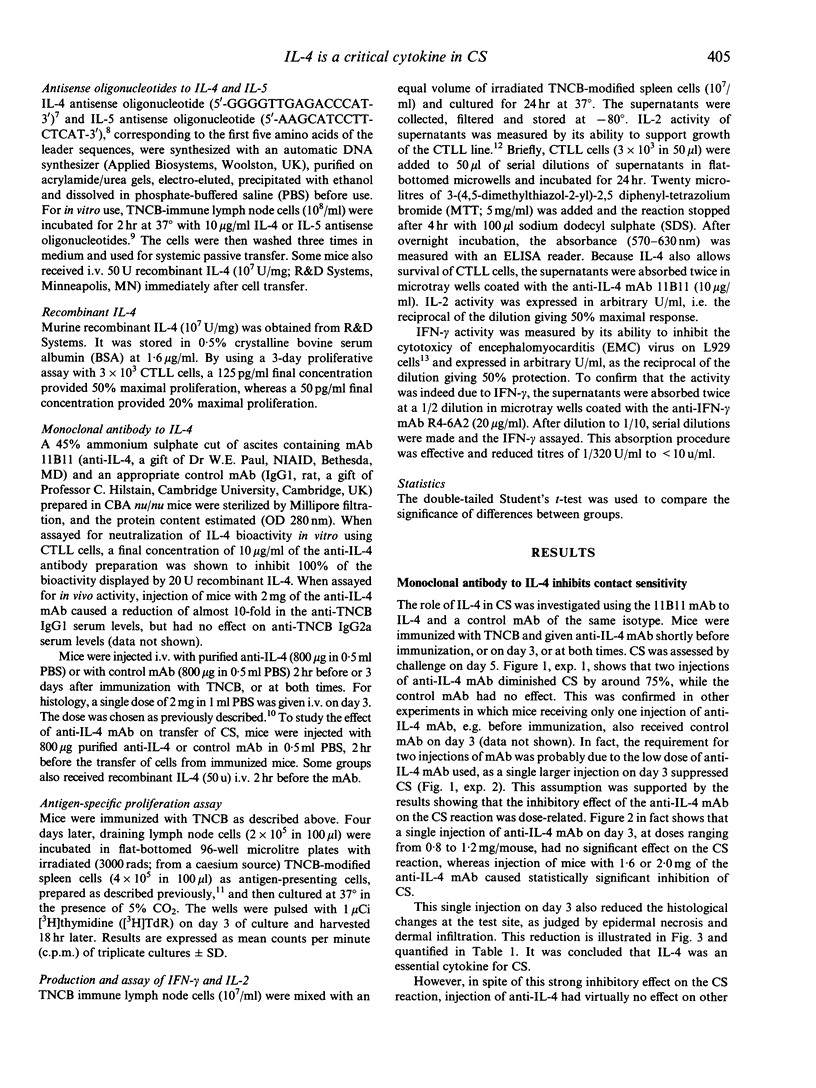
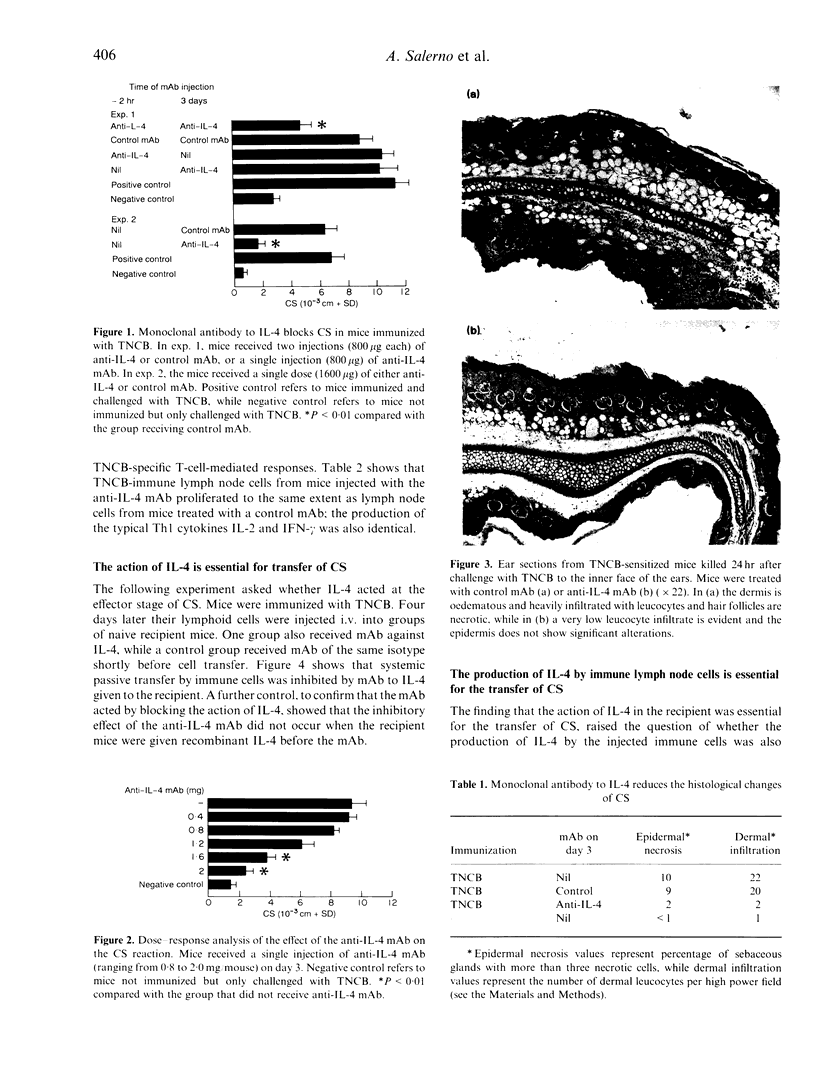
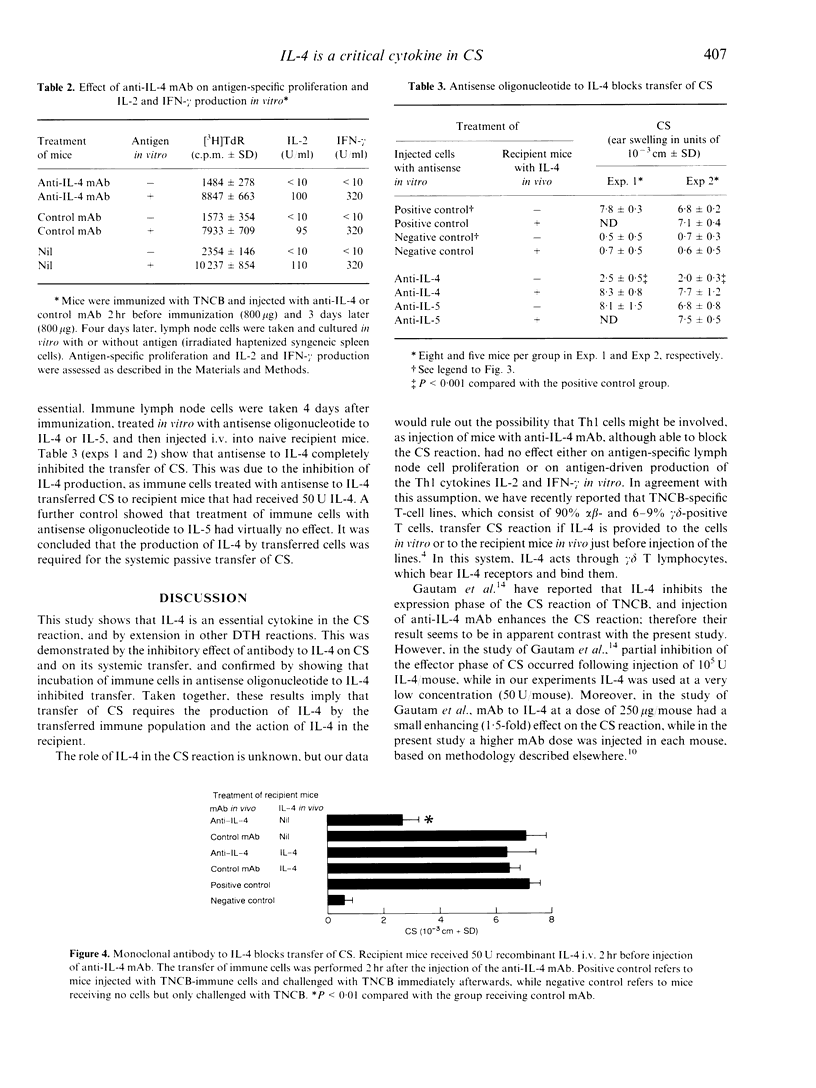
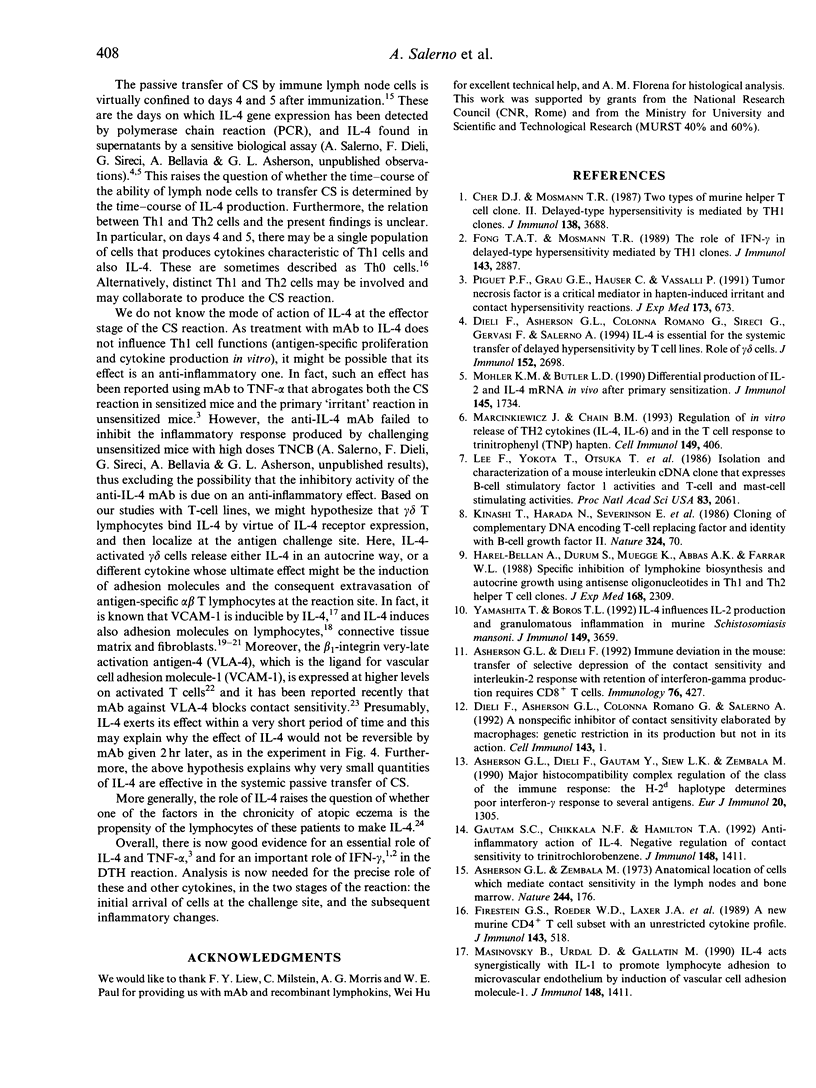
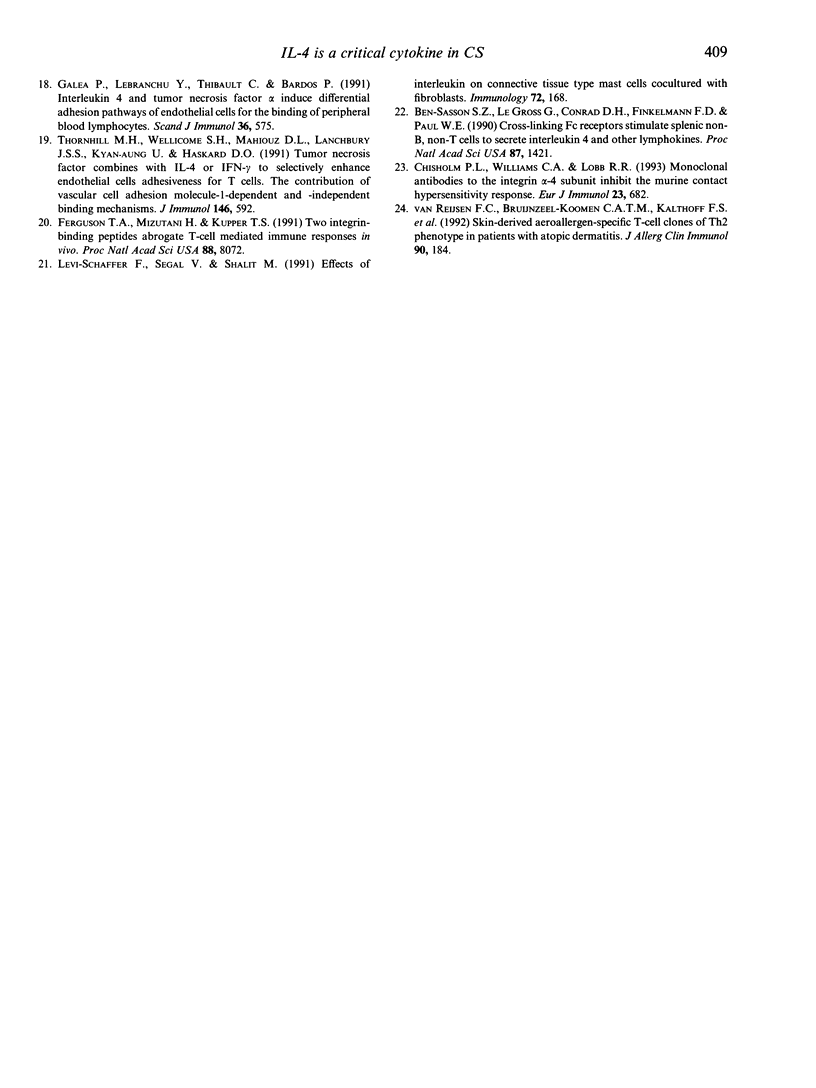
Images in this article
Selected References
These references are in PubMed. This may not be the complete list of references from this article.
- Asherson G. L., Dieli F., Gautam Y., Siew L. K., Zembala M. Major histocompatibility complex regulation of the class of the immune response: the H-2d haplotype determines poor interferon-gamma response to several antigens. Eur J Immunol. 1990 Jun;20(6):1305–1310. doi: 10.1002/eji.1830200616. [DOI] [PubMed] [Google Scholar]
- Asherson G. L., Dieli F. Immune deviation in the mouse: transfer of selective depression of the contact sensitivity and interleukin-2 response with retention of interferon-gamma production requires CD8+ T cells. Immunology. 1992 Jul;76(3):427–432. [PMC free article] [PubMed] [Google Scholar]
- Asherson G. L., Zembala M. Anatomical location of cells which mediate contact sensitivity in the lympho nodes and bone marrow. Nat New Biol. 1973 Aug 8;244(136):176–177. doi: 10.1038/newbio244176a0. [DOI] [PubMed] [Google Scholar]
- Ben-Sasson S. Z., Le Gros G., Conrad D. H., Finkelman F. D., Paul W. E. Cross-linking Fc receptors stimulate splenic non-B, non-T cells to secrete interleukin 4 and other lymphokines. Proc Natl Acad Sci U S A. 1990 Feb;87(4):1421–1425. doi: 10.1073/pnas.87.4.1421. [DOI] [PMC free article] [PubMed] [Google Scholar]
- Cher D. J., Mosmann T. R. Two types of murine helper T cell clone. II. Delayed-type hypersensitivity is mediated by TH1 clones. J Immunol. 1987 Jun 1;138(11):3688–3694. [PubMed] [Google Scholar]
- Chisholm P. L., Williams C. A., Lobb R. R. Monoclonal antibodies to the integrin alpha-4 subunit inhibit the murine contact hypersensitivity response. Eur J Immunol. 1993 Mar;23(3):682–688. doi: 10.1002/eji.1830230317. [DOI] [PubMed] [Google Scholar]
- Dieli F., Asherson G. L., Romano G. C., Sireci G., Gervasi F., Salerno A. IL-4 is essential for the systemic transfer of delayed hypersensitivity by T cell lines. Role of gamma/delta cells. J Immunol. 1994 Mar 15;152(6):2698–2704. [PubMed] [Google Scholar]
- Ferguson T. A., Mizutani H., Kupper T. S. Two integrin-binding peptides abrogate T cell-mediated immune responses in vivo. Proc Natl Acad Sci U S A. 1991 Sep 15;88(18):8072–8076. doi: 10.1073/pnas.88.18.8072. [DOI] [PMC free article] [PubMed] [Google Scholar]
- Firestein G. S., Roeder W. D., Laxer J. A., Townsend K. S., Weaver C. T., Hom J. T., Linton J., Torbett B. E., Glasebrook A. L. A new murine CD4+ T cell subset with an unrestricted cytokine profile. J Immunol. 1989 Jul 15;143(2):518–525. [PubMed] [Google Scholar]
- Fong T. A., Mosmann T. R. The role of IFN-gamma in delayed-type hypersensitivity mediated by Th1 clones. J Immunol. 1989 Nov 1;143(9):2887–2893. [PubMed] [Google Scholar]
- Galéa P., Lebranchu Y., Thibault G., Bardos P. Interleukin 4 and tumour necrosis factor alpha induce different adhesion pathways in endothelial cells for the binding of peripheral blood lymphocytes. Scand J Immunol. 1992 Oct;36(4):575–585. doi: 10.1111/j.1365-3083.1992.tb03226.x. [DOI] [PubMed] [Google Scholar]
- Gautam S. C., Chikkala N. F., Hamilton T. A. Anti-inflammatory action of IL-4. Negative regulation of contact sensitivity to trinitrochlorobenzene. J Immunol. 1992 Mar 1;148(5):1411–1415. [PubMed] [Google Scholar]
- Harel-Bellan A., Durum S., Muegge K., Abbas A. K., Farrar W. L. Specific inhibition of lymphokine biosynthesis and autocrine growth using antisense oligonucleotides in Th1 and Th2 helper T cell clones. J Exp Med. 1988 Dec 1;168(6):2309–2318. doi: 10.1084/jem.168.6.2309. [DOI] [PMC free article] [PubMed] [Google Scholar]
- Kinashi T., Harada N., Severinson E., Tanabe T., Sideras P., Konishi M., Azuma C., Tominaga A., Bergstedt-Lindqvist S., Takahashi M. Cloning of complementary DNA encoding T-cell replacing factor and identity with B-cell growth factor II. Nature. 1986 Nov 6;324(6092):70–73. doi: 10.1038/324070a0. [DOI] [PubMed] [Google Scholar]
- Lee F., Yokota T., Otsuka T., Meyerson P., Villaret D., Coffman R., Mosmann T., Rennick D., Roehm N., Smith C. Isolation and characterization of a mouse interleukin cDNA clone that expresses B-cell stimulatory factor 1 activities and T-cell- and mast-cell-stimulating activities. Proc Natl Acad Sci U S A. 1986 Apr;83(7):2061–2065. doi: 10.1073/pnas.83.7.2061. [DOI] [PMC free article] [PubMed] [Google Scholar]
- Marcinkiewicz J., Chain B. M. Regulation of in vitro release of TH2 type cytokines (IL-4, IL-6) in the T cell response to the trinitrophenyl (TNP) hapten. Cell Immunol. 1993 Feb;146(2):406–411. doi: 10.1006/cimm.1993.1036. [DOI] [PubMed] [Google Scholar]
- Mohler K. M., Butler L. D. Differential production of IL-2 and IL-4 mRNA in vivo after primary sensitization. J Immunol. 1990 Sep 15;145(6):1734–1739. [PubMed] [Google Scholar]
- Piguet P. F., Grau G. E., Hauser C., Vassalli P. Tumor necrosis factor is a critical mediator in hapten induced irritant and contact hypersensitivity reactions. J Exp Med. 1991 Mar 1;173(3):673–679. doi: 10.1084/jem.173.3.673. [DOI] [PMC free article] [PubMed] [Google Scholar]
- Thornhill M. H., Wellicome S. M., Mahiouz D. L., Lanchbury J. S., Kyan-Aung U., Haskard D. O. Tumor necrosis factor combines with IL-4 or IFN-gamma to selectively enhance endothelial cell adhesiveness for T cells. The contribution of vascular cell adhesion molecule-1-dependent and -independent binding mechanisms. J Immunol. 1991 Jan 15;146(2):592–598. [PubMed] [Google Scholar]
- Yamashita T., Boros D. L. IL-4 influences IL-2 production and granulomatous inflammation in murine schistosomiasis mansoni. J Immunol. 1992 Dec 1;149(11):3659–3664. [PubMed] [Google Scholar]
- van Reijsen F. C., Bruijnzeel-Koomen C. A., Kalthoff F. S., Maggi E., Romagnani S., Westland J. K., Mudde G. C. Skin-derived aeroallergen-specific T-cell clones of Th2 phenotype in patients with atopic dermatitis. J Allergy Clin Immunol. 1992 Aug;90(2):184–193. doi: 10.1016/0091-6749(92)90070-i. [DOI] [PubMed] [Google Scholar]



